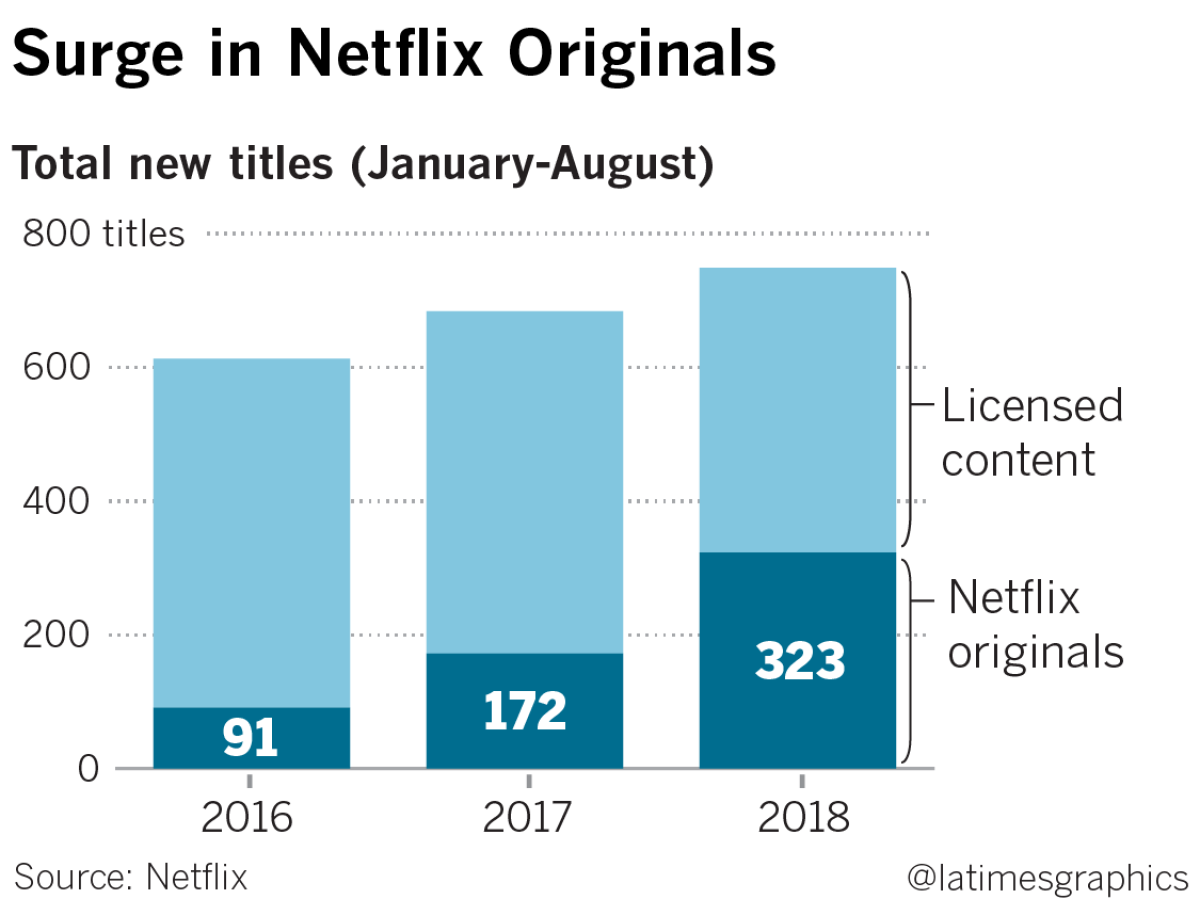Must Reads: As Netflix surges, original content is the new black. But licensed shows still take the crown
- Share via
Netflix’s promotional tagline is “See what’s next” — a nod to the numerous titles that are instantly available to watch at the click of a remote. For the streaming entertainment giant, “what’s next” is changing in dramatic ways.
While it once depended almost exclusively on old licensed titles from other studios such as “Breaking Bad,” “South Park” and “The Walking Dead,” Netflix is betting that a steady diet of original content will sustain its business.
A Times analysis shows a surge in “Netflix Original”-branded titles in the U.S. over the last three years. The number of new original titles released so far this year is more than triple the number from the same period in 2016. In August, more than 53% of new releases will be Netflix Originals — the first time the company has added more original than licensed content on a monthly basis.
The aggressive move toward original programming is having a palpable effect on content available to subscribers and reflects Netflix’s ambition to dominate Hollywood. The Los Gatos, Calif., company has already upended traditional distribution models and is now lessening its reliance on content from competing studios to fill its direct-to-consumer pipeline.
But this change could also pose challenges for Netflix as it licenses fewer of the popular titles that have played a crucial role in retaining subscribers. With competition heating up from Amazon Prime Video and Walt Disney Co.’s upcoming streaming service, subscriber gains and retention have become the key metric by which Wall Street measures the company’s future viability and cash flow. Last quarter, Netflix missed its new subscriber forecast by about 1 million customers, sending its shares tumbling. The company currently counts 130.1 million subscribers worldwide.
For now, Netflix is betting that more original shows and movies will equate to even more subscribers.
Netflix original content accounts for 43.1% of all new titles so far this year, up from 25.2% at the same point last year, and just 15% in 2016, according to a Times analysis of new releases. The Times aggregated all of Netflix’s new titles, which are disclosed monthly, over the last three years and categorized each TV show or feature film as either a Netflix-branded original or as licensed content.

Original-branded content on Netflix includes such self-produced series as “Stranger Things” and “3%,” as well as the movies “Bright” and “Mudbound.” But it also includes studio partnerships such as the acclaimed series “The Crown,” which is a Sony Television production, and “Orange Is the New Black,” which is from Lionsgate.
Netflix appears to be pursuing a something-for-everyone strategy, offering a wide range of programs from stand-up comedy specials to sci-fi dramas, romantic comedies and crime documentaries that appeal to their “taste communities” — broadly defined groups of subscribers who gravitate toward the same shows.
“Demographics aren’t a good indicator of what people like to watch,” said Cindy Holland, who serves as vice president of original series for Netflix, at a recent presentation at the Television Critics Assn. press tour in Beverly Hills.
Taste communities help drive the content recommendations subscribers see when they log on to the service. Netflix’s algorithm will promote the shows that other subscribers in the same community enjoyed, making those titles more visible to the browsing viewer.
“The most powerful promotional vehicle we have is the Netflix service itself,” Holland said.
At the same time, Netflix is adding fewer older TV shows and movies from other studios, in part because some studios are holding on to their content, reflecting Hollywood’s conflicted and sometimes strained relationship with the company.
As a mail-order DVD service, Netflix became a lucrative source of home video revenue to the studios. And when Netflix launched its streaming service in 2007, studios secured even more money for the rights to their old movies and TV reruns. But Netflix has also accelerated the migration of viewers away from traditional TV and lured major producing talent such as Shonda Rhimes and Ryan Murphy away from TV networks such as ABC and Fox.
Notably, newly licensed content from other studios is down nearly 17% this year compared with the same time last year.
“Netflix needs to be less dependent on third-party IP or content, or its margins will erode over time,” said Ashwin Navin, co-founder and chief executive of Samba TV, a television data and analytics firm.
Netflix, which declined to comment, adds and removes titles on an almost continual basis, making it difficult to gauge its overall content mix at any given time. Experts estimate that Netflix Originals still represent less than 10% of all content available on the service.
That figure is expected to rise as Netflix continues to pump out more shows and movies at breakneck speed. The company has forecast spending $7 billion to $8 billion this year on original and licensed content, up from around $6 billion last year. But some say the actual 2018 content spend will be higher. The Economist, citing data from Goldman Sachs, put the figure in the $12-billion to $13-billion range.
Netflix executives have stated that investing more in original content will benefit the company by insulating it from rising licensing costs. While the short-term cash outlay is higher, the company will own its self-produced content in perpetuity.
Ted Sarandos, chief content officer for Netflix, said this year at MoffettNathanson’s Media & Communications Summit that the company doesn’t break out spending on originals versus licensed content. But he said that 85% of all new spending is on original programming.
So far this year, the number of new original releases on Netflix is up nearly 88% from the same time last year, according to the Times analysis. New titles debuting soon include “Disenchantment,” a new animated series from Matt Groening, the creator of “The Simpsons,” and “Maniac,” a futuristic miniseries starring Emma Stone and Jonah Hill.
David Wells, chief financial officer for Netflix, said in February that the service will have about 700 original TV shows worldwide by the end of the year.
The company is also bulking up its movie output — one-third of the new original titles this year are films. While Netflix Original features have often been regarded as inferior in quality to major studio releases, the streaming service has invested heavily in auteur prestige projects. This year will see the release of new features by the Coen brothers, Alfonso Cuaron and Paul Greengrass. Netflix is also behind the next Martin Scorsese movie, “The Irishman,” whose rumored price tag exceeds $100 million.
Netflix’s day-and-date release strategy, however, has aggravated cinema owners, who object to the way the company releases some of its original movies online and in a handful of theaters on the same day.
Overall, Netflix executives expect to release 1,000 original titles this year. The goal is for half of all content to be originals, though no timeline has been announced. In the meantime, older licensed content — often called catalog or library titles — will continue to play a vital role.
“In the streaming world, they are gold,” said one senior studio executive. “I would argue on some level, it’s the originals that drive subscriptions. But it’s the catalog that helps keep people engaged. Spending is skewed toward originals, and viewing is skewed toward the library.”
He said Netflix is roughly where HBO was more than a decade ago as it figures out the right mix of original and licensed content. In a sign of its ascendance, Netflix this year nudged past HBO with 112 Emmy nominations, the most of any network and more than double its total from two years ago.
But in terms of the sheer volume of views on Netflix, the crown still goes to licensed shows from other studios.
Old TV series especially continue to be a major draw, according to a recent study from research firm 7Park Data. The study showed that 80% of TV streams on Netflix are licensed TV shows, and that 42% of viewers watch little to no Netflix Original content.
“The hours of watching would be heavily skewed towards licensed content because there is more of it.… We may have 300 episodes of the show versus 13 of one of our own shows,” Sarandos said at the MoffettNathanson conference. “So, it makes sense that the licensed content would be getting more viewing.”
Netflix is famously secretive about its viewership data and doesn’t release show ratings like traditional broadcast companies. Sarandos has downplayed outside research, saying that such reports often rely on sampling or models.
Shows with passionate fan bases, such as NBC’s “The Office” and AMC’s “Breaking Bad,” continue to attract large numbers of viewers.
“Familiar licensed series have established audiences, and while consumption of originals grows, the appeal of licensed content continues to translate into massive streaming,” the 7Park Data study said.
As licensed content on Netflix wanes, subscribers are seeing some of their favorite titles disappear. Fox’s “Family Guy” and FX’s “Archer” exited the service earlier this year, while “South Park” is now streaming exclusively on Hulu.
The shift comes as the licensing market is undergoing radical changes, making it more challenging for Netflix to buy popular titles off the shelf.
Walt Disney Co. is ending its output deal with Netflix in 2019, pulling its movies as it launches a competing streaming service, which means Netflix subscribers will have access to fewer blockbuster movie titles.
TV shows from Disney-owned ABC and 20th Century Fox are likely to go to the Disney service or to Hulu, after Disney’s acquisition of most of 21st Century Fox. And many studios are holding on to the lucrative international rights for the TV shows they sell to Netflix as they expand their own global operations.
Netflix could also face licensing challenges as vertically integrated media companies such as Comcast and AT&T explore direct-to-consumer options for content from their respective studios — NBCUniversal and WarnerMedia.
“It won’t necessarily kill the licensing industry, but I can see a shift towards closed content ecosystems,” said Clement Thibault, a senior analyst at Investing.com, where he follows Netflix and other streaming media companies.
Vertically integrated media companies already are rethinking their licensing strategies, analysts say.
“It’s less strategic for them to license to Netflix,” said Navin of Samba TV. As a result, “it’s a critical imperative for Netflix to build its own catalog.”
But Netflix is also getting pickier when it comes to licensed content.
“We, like others, have seen Netflix become more discriminating in what they are interested in,” said another studio executive who works in distribution who was not authorized to comment publicly. While Hulu has become more aggressive in the last couple of years when it comes to buying library content, Netflix has grown “a little less enthusiastic,” the executive said.
Times Staff Writer Meg James contributed to this report
More to Read
Inside the business of entertainment
The Wide Shot brings you news, analysis and insights on everything from streaming wars to production — and what it all means for the future.
You may occasionally receive promotional content from the Los Angeles Times.











